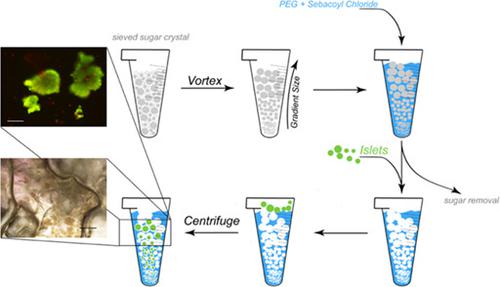当前位置:
X-MOL 学术
›
J. Biomed. Mater. Res. Part B Appl. Biomater.
›
论文详情
Our official English website, www.x-mol.net, welcomes your feedback! (Note: you will need to create a separate account there.)
Facile preparation of tissue engineering scaffolds with pore size gradients using the muesli effect and their application to cell spheroid encapsulation.
Journal of Biomedical Materials Research Part B: Applied Biomaterials ( IF 3.4 ) Pub Date : 2020-02-12 , DOI: 10.1002/jbm.b.34581 Aurelien Forget 1, 2 , Darling Rojas 3 , Michaela Waibel 4 , Daniella Pencko 3, 5 , Satyathiran Gunenthiran 1, 6 , Neethu Ninan 1, 6 , Thomas Loudovaris 4 , Chris Drogemuller 3, 5 , Patrick T Coates 3, 5 , Nicolas H Voelcker 6, 7, 8 , Anton Blencowe 1, 6
Journal of Biomedical Materials Research Part B: Applied Biomaterials ( IF 3.4 ) Pub Date : 2020-02-12 , DOI: 10.1002/jbm.b.34581 Aurelien Forget 1, 2 , Darling Rojas 3 , Michaela Waibel 4 , Daniella Pencko 3, 5 , Satyathiran Gunenthiran 1, 6 , Neethu Ninan 1, 6 , Thomas Loudovaris 4 , Chris Drogemuller 3, 5 , Patrick T Coates 3, 5 , Nicolas H Voelcker 6, 7, 8 , Anton Blencowe 1, 6
Affiliation

|
Porous biodegradable scaffolds have many applications in bioengineering, ranging from cell culture and transplantation, to support structures, to induce blood vessel and tissue formation in vivo. While numerous strategies have been developed for the manufacture of porous scaffolds, it remains challenging to control the spatial organization of the pores. In this study, we introduce the use of the granular convection effect, also known as the muesli or brazil nut effect, to rapidly engineer particulate templates with a vertical size gradient. These templates can then be used to prepare scaffolds with pore size gradients. To demonstrate this approach, we prepared templates with particle size gradients, which were then infused with a prepolymer solution consisting of the pentaerythritol ethoxylate (polyol), sebacoyl chloride (acid chloride), and poly(caprolactone). Following curing, the template was dissolved to yield biodegradable polyester‐ether scaffolds with pore size gradients that could be tuned depending on the size range of the particulates used. The application of these scaffolds was demonstrated using pancreatic islets, which were loaded via centrifugation and retained within the scaffold's pores without a decrease in viability. The proposed strategy provides a facile approach to prepare templates with spatially organized pores that could potentially be used for cell transplantation, or guided tissue formation.
中文翻译:

使用 muesli 效应轻松制备具有孔径梯度的组织工程支架及其在细胞球体封装中的应用。
多孔可生物降解支架在生物工程中有许多应用,从细胞培养和移植到支撑结构,以诱导体内血管和组织形成。虽然已经开发了许多用于制造多孔支架的策略,但控制孔的空间组织仍然具有挑战性。在这项研究中,我们介绍了使用颗粒对流效应(也称为 muesli 或巴西坚果效应)来快速设计具有垂直尺寸梯度的颗粒模板。然后可以使用这些模板来制备具有孔径梯度的支架。为了演示这种方法,我们制备了具有粒度梯度的模板,然后将其注入由季戊四醇乙氧基化物(多元醇)、癸二酰氯(酰氯)、和聚(己内酯)。固化后,将模板溶解以产生可生物降解的聚酯-醚支架,其孔径梯度可根据所用颗粒的尺寸范围进行调整。使用胰岛证明了这些支架的应用,胰岛通过离心加载并保留在支架的孔内,而没有降低生存能力。所提出的策略提供了一种简单的方法来制备具有空间组织孔的模板,这些孔有可能用于细胞移植或引导组织形成。使用胰岛证明了这些支架的应用,胰岛通过离心加载并保留在支架的孔内,而没有降低生存能力。所提出的策略提供了一种简单的方法来制备具有空间组织孔的模板,这些孔有可能用于细胞移植或引导组织形成。使用胰岛证明了这些支架的应用,胰岛通过离心加载并保留在支架的孔内,而没有降低生存能力。所提出的策略提供了一种简单的方法来制备具有空间组织孔的模板,这些孔有可能用于细胞移植或引导组织形成。
更新日期:2020-02-12
中文翻译:

使用 muesli 效应轻松制备具有孔径梯度的组织工程支架及其在细胞球体封装中的应用。
多孔可生物降解支架在生物工程中有许多应用,从细胞培养和移植到支撑结构,以诱导体内血管和组织形成。虽然已经开发了许多用于制造多孔支架的策略,但控制孔的空间组织仍然具有挑战性。在这项研究中,我们介绍了使用颗粒对流效应(也称为 muesli 或巴西坚果效应)来快速设计具有垂直尺寸梯度的颗粒模板。然后可以使用这些模板来制备具有孔径梯度的支架。为了演示这种方法,我们制备了具有粒度梯度的模板,然后将其注入由季戊四醇乙氧基化物(多元醇)、癸二酰氯(酰氯)、和聚(己内酯)。固化后,将模板溶解以产生可生物降解的聚酯-醚支架,其孔径梯度可根据所用颗粒的尺寸范围进行调整。使用胰岛证明了这些支架的应用,胰岛通过离心加载并保留在支架的孔内,而没有降低生存能力。所提出的策略提供了一种简单的方法来制备具有空间组织孔的模板,这些孔有可能用于细胞移植或引导组织形成。使用胰岛证明了这些支架的应用,胰岛通过离心加载并保留在支架的孔内,而没有降低生存能力。所提出的策略提供了一种简单的方法来制备具有空间组织孔的模板,这些孔有可能用于细胞移植或引导组织形成。使用胰岛证明了这些支架的应用,胰岛通过离心加载并保留在支架的孔内,而没有降低生存能力。所提出的策略提供了一种简单的方法来制备具有空间组织孔的模板,这些孔有可能用于细胞移植或引导组织形成。


























 京公网安备 11010802027423号
京公网安备 11010802027423号